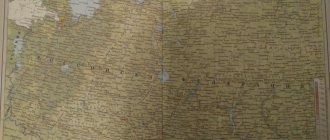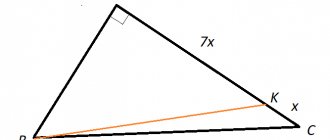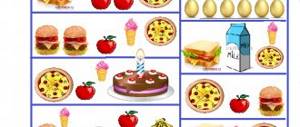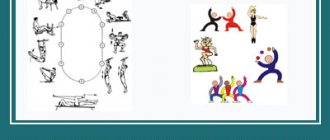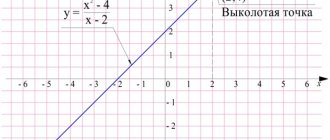Summary of an algebra lesson in 7th grade according to the Federal State Educational Standard. Function graphs
Algebra lesson in 7th grade on the topic “Graphs of Functions”
Author: Butorina Victoria Vitalievna mathematics teacher of MAOU “Baikalovskaya Secondary School”, Tobolsk district, Tyumen region Description of work: The material is intended for mathematics teachers.
The lesson script is compiled in accordance with the Federal State Educational Standard. The work used tasks similar to the OGE tasks from the “Real Mathematics” section. Goals: Educational: • Formation in students of the concept of a function and its graph. Educational: • Cultivating accuracy and attentiveness when performing tasks; • Contribute to the acquisition of the necessary skills for independent learning activities. Developmental: • Development of students’ skills to summarize acquired knowledge, conduct analysis and comparisons, and draw the necessary conclusions; • Development of skills to competently, clearly and accurately express your thoughts (formulate an answer or conclusion). Objectives: • Repeat the concepts of “graph”, “graph of real dependence”; • Give the concepts of “linear function”, “domain of definition of a function”; • Get acquainted with the graph of a linear function; • Develop the skill of working with graphs of real dependencies; • Reveal the application of mathematical knowledge about graphs in various professions; • Consolidate the acquired knowledge by solving OGE tasks from the modules “Real Mathematics” and “Algebra”. During the classes
An engineer and mathematician will become rich only if he is able to apply a coordinate system.
I. Kushnir, L. Finkelstein 1. Organizational-psychological moment Teacher’s activities:
Hello guys.
I am glad to see everyone present at this lesson. Students’ activities:
Cognitive: Getting ready for work Setting a goal: “What do I want to learn today in class?” Communicative: Concentrating attention Planning educational cooperation with the teacher and classmates Regulatory: Self-determining and getting ready for lesson
2. Motivation Teacher’s activity:
On my desk collected various items: flashlight, telephone, socket, thermometer, cardiogram, navigator (course indicator), laptop, banknote.
thermograph. What unites all these items? (the operation of each of these devices can be described using a function graph) Show the presentation after answering the question. Student activities:
Cognitive: Constructing a logical chain of reasoning and putting forward hypotheses and their justification By analyzing and comparing selected tasks, they extract the necessary information to introduce a new concept.
They draw up a plan to achieve the goal and determine the means Communicative: They answer questions asked during the discussion, cooperate in searching and selecting information Express their thoughts with sufficient completeness and accuracy, give reasons for their opinions Regulatory: Participate in dialogue When a situation arises, difficulties regulate the train of thought 3. Updating subjective experience Teacher's activity:
Breathing and heartbeat are our life, and our heart on a cardiogram produces a graph that a cardiologist must be able to read correctly.
I suggest you now act as a cardiologist and evaluate the presented cardiograms. What can you tell about a person’s health from a cardiogram? (2 - too rapid heartbeat, 3 - rare heartbeat, 4 - uneven heartbeat) 1. cardiogram of a healthy person 2. cardiogram of a person suffering from tachycardia 3. cardiogram of a person suffering from bradycardia 4. cardiogram of a person suffering from arrhythmia Student activities:
Cognitive: Learn to apply determinations in the process of independent decision or work at the board or in pair work. Independently plans his activities, applies solution methods and predicts the result.
Builds a logical chain of reasoning in the process of solving problems Communicative: Managing the partner’s behavior, monitoring and correction, evaluating the partner’s actions Plan cooperation with classmates and the teacher, take into account the opinion of the pair and coordinate their actions Regulatory: Monitoring the work of one’s own and the partner, evaluating and correcting the activities Demonstrate cognitive initiative 4. Chaining. Teacher's activity:
Why do we need to study graphs of functions and is it necessary?
(For the ability to navigate in life situations, for successfully passing the exam) Student activities:
Cognitive: Constructing a logical chain of reasoning and putting forward hypotheses and their justification Analyzing and comparing the examples given, extract the necessary information for summing up a new concept, formulate the concept of proper and improper fractions Communicative : Recognize the need to formulate the topic and purpose of the lesson Express their thoughts with sufficient completeness and accuracy, give reasons for their opinions Regulatory: Participate in dialogue and learn to give examples In a situation of difficulty, regulate the course of thoughts
5. Discovery of new knowledge Teacher’s activities:
Organize work with differentiated tasks on student choice (3 options for tasks with self-test using a template)
Student activity:
Cognitive: Learn to apply acquired knowledge in the process of individual work Independently perform actions according to the algorithm Communicative: Perform a task to determine a value from a graph or calculate a value from a graph Understand the algorithm used with sufficient completeness Regulatory : Monitoring the correctness of assignments, awareness of the quality and level of assimilation. Shows cognitive initiative.
Control their actions 6. Organize students’ activities to use knowledge in standard and modified situations. Teacher activity:
Study the presented graph.
Compose and write down a question about the graph of the function. Write down the answer to the question posed separately. Invite your classmates to answer the questions posed. Evaluate your classmate's work. Student activities:
Cognitive: Learn to apply acquired knowledge in the process of individual work. Independently plans their activities, applies solution methods and predicts the result.
Builds a logical chain of reasoning in the process of solving problems Communicative: Managing the partner’s behavior, monitoring and correction, evaluating the partner’s actions Plan cooperation with classmates and the teacher, take into account the opinion of the pair and coordinate their actions Regulatory: Monitoring the work of one’s own and the partner, evaluating and correcting the activities Demonstrate cognitive initiative 7. Reflection. Teacher's activities:
Organizing reflection "Cartesian coordinate system"
Students' activities:
Cognitive: Conduct reflection on the methods and conditions of their actions Communicative: Plan cooperation, use criteria to justify their judgments Regulatory: Conduct self-assessment
8. Information about homework Teacher's activities:
On the sdamgia website. ru posted sample tasks for the state final certification.
Work with tasks 5, 14,15 Appendix No. 1 Appendix No. 2 Option No. 1 1. The graph shows the change in air temperature in a certain locality for three days, starting from 0 o'clock on Saturday. The x-axis shows the time of day in hours, and the y-axis shows the temperature in degrees Celsius. Using the graph, determine the lowest air temperature on the night from Saturday to Sunday. Give your answer in degrees Celsius.
2. The figure shows a graph of the flight of a body thrown at an angle to the horizon. The vertical axis shows the distance from the ground (in m), and the horizontal axis shows the distance traveled (in m). Based on the drawing, determine at what height the body will be at the moment when it flies 60 meters.
3. In the figure, bold dots show the price of tin at the close of exchange trading on all working days from November 12 to November 28, 2007. The dates of the month are indicated horizontally, and the price of a ton of tin in US dollars is indicated vertically. For clarity, the bold points in the figure are connected by a line. Determine from the figure what date the price of tin at the close of trading was the highest for the given period.
4. At the airport, passengers' suitcases are lifted into the baggage claim area along a conveyor belt. When designing a conveyor, it is necessary to take into account the permissible tension force of the conveyor belt. The figure shows the dependence of the belt tension on the angle of inclination of the conveyor to the horizon at the design load. On the abscissa axis is the elevation angle in degrees, on the ordinate axis is the tension force of the conveyor belt (in kilograms of force). At what angle of inclination does the tension force reach 150 kgf? Give your answer in degrees.
Option No. 2 1. The graph shows the change in air temperature over three days, starting from 0 o'clock on July 11. The time of day is indicated on the abscissa axis, and the temperature value in degrees is indicated on the ordinate axis. Determine from the graph to what maximum temperature the air warmed up on July 13th. Give your answer in degrees Celsius.
2. The power of the heater in the car is regulated by an additional resistance, which can be changed by turning the handle inside the car. At the same time, the current strength in the electrical circuit of the electric motor changes - the lower the resistance, the greater the current strength and the faster the heater motor rotates. The figure shows the dependence of the current on the resistance value. The abscissa axis shows the resistance (in Ohms), and the ordinate axis shows the current strength in Amperes. The current in the electric motor circuit decreased from 8 to 6 Amperes. By how many ohms does this increase the circuit resistance?
3. In the figure, bold dots show the price of gold at the close of exchange trading on all working days from October 3 to October 24, 2002. The dates of the month are indicated horizontally, and the price of an ounce of gold in US dollars is indicated vertically. For clarity, the bold points in the figure are connected by a line. Determine from the figure the highest price of gold at the close of trading in the period from October 15 to October 23 (in US dollars per ounce).
4. The graphs show how, during the televised debate between candidates A and B, viewers voted for each of them. How many TV viewers had voted for candidate B by the 40th minute of the debate?
Option No. 3 1. The figure shows the change in air temperature over three days. The date and time of day are indicated horizontally, and the temperature value in degrees Celsius is indicated vertically. Determine the difference between the highest and lowest air temperatures on December 19 from the figure. Appendix No. 3 1. Moscow-Vladimir bus schedule
Question: _____________________________________________ 2. Tourist movement schedule.
Question: _____________________________________________ 3. Traffic schedules for a motorist and a motorcyclist.
Question: _____________________________________________
We recommend watching:
Lesson notes for 7th grade algebra lesson. Multiplying a monomial by a polynomial 7th grade algebra lesson notes. Factorization Summary of an algebra lesson in 7th grade with a presentation on the Federal State Educational Standard. Dividing a monomial by a monomial Technological map of an algebra lesson in the 7th grade according to the Federal State Educational Standard. Factoring polynomials using
Similar articles:
Summary of an algebra lesson in 7th grade on the topic: “Degree with a natural exponent. Monomial"
Summary of an algebra lesson in 7th grade “Abbreviated multiplication formulas”
Summary of an algebra lesson in 7th grade on the topic “Polynomial. Standard form of a polynomial"
Math quizzes with answers, 7th grade
Algebra lesson notes 7th grade
Lesson summary
Certified teacher: Elena Nikolaevna Sindeeva___________________________________________
Subject: Algebra______________________________Grade 7_____________________________________________
Lesson topic: “Relative arrangement of graphs of linear functions.”_________________________________________________________
Objectives of studying the topic
:
Meta-subject (developmental):
Communicative:
create conditions for the development of communication skills;
Regulatory:
create conditions for the development of skills to analyze, compare, and draw conclusions; to demonstrate initiative and independence;
Cognitive:
create conditions for developing skills in working with ready-made tests;
Subject (educational): promote the assimilation of the relative position of graphs of linear functions;
create conditions for developing skills in applying acquired knowledge.
Personal (educational): promote a positive attitude towards academic work; skill
express your point of view and listen to others.
Lesson Objectives
:
- Check your homework.
- Review theoretical material on the previous topic.
- Strengthen the ability to work according to ready-made schedules.
- Develop the ability to observe, analyze, and draw conclusions.
- Check your understanding of the material.
Lesson type
: primary consolidation of new knowledge.
Educational and didactic support for the lesson and teaching aids:
, tests, individual cards, tables, presentation.
(When writing a lesson summary at each of its stages, it is necessary to reflect the goals and objectives of the teacher and student, methods and means of achieving the goals, the main subject content of the relevant stages, the organization of work at each stage, taking into account the real characteristics of the class in which this lesson was held in the previous period)
Contents of stage
1.
Organizing time
,
including:
- setting a goal that must be achieved by students at this stage of the lesson (what must be done by students in order for their further work in the lesson to be effective)
- determining the goals and objectives that the teacher wants to achieve at this stage of the lesson;
- description of methods for organizing students’ work at the initial stage of the lesson, setting students up for learning activities, the subject and topic of the lesson (taking into account the real characteristics of the class with which the teacher works)
Teacher: Hello, guys! Let's remember what we studied in the last lessons. Let's decide what we have to do today.
Student: We studied the linear function. Today we will continue our work on studying the relative positions of graphs of linear functions. We must study the relative positions of graphs of linear functions and be able to apply them in practice.
The purpose of the lesson stage: To promote a positive attitude towards educational work, the ability to express one’s point of view and listen to someone else’s.
Didactic objectives of the lesson stage: Get into the business rhythm, prepare for work, develop communication skills, develop the ability to analyze an action plan.
Method of organizing students' work: Oral communication from the teacher.
Form of organization of educational activities: Conversation.
Teacher: Today we are working using images on the TV screen, please follow the rules of conduct in class. Everyone has a sheet on their desk with a lesson plan where you will make your suggestions. Try to work actively. At the end of the lesson, please indicate your attitude towards the lesson and indicate your mood.
Teacher's activity: Voices the topic, plan and purpose of the lesson.
Student activity: Analyze and comment on the lesson plan.
Teacher: Guys, here is a lesson plan, analyze it and make your suggestions.
Lesson plan:
- Oral work.
- Working with cards.
- Checking homework.
- Oral completion of tasks on the topic, according to ready-made schedules.
- Independent work on options in pairs.
- Executing the test.
- Summarizing.
- Homework.
Result: Students analyze the lesson plan and make their suggestions.
2.
Survey of students on homework assignments
, including:
- determining the goals that the teacher sets for students at this stage of the lesson (what result should be achieved by students);
- determining the goals and objectives that the teacher wants to achieve at this stage of the lesson;
- description of methods that contribute to solving set goals and objectives;
- description of the criteria for achieving the goals and objectives of this stage of the lesson;
- determining possible actions of the teacher if he or the students fail to achieve their goals;
- a description of methods for organizing joint activities of students, taking into account the characteristics of the class with which the teacher works;
- description of methods of motivating (stimulating) students' learning activity during the survey;
- description of methods and criteria for assessing student responses during the survey.
Teacher: 3 people are working at the board, solving examples from homework:
I: y=-4x-1 and y=2x+5
II: y=-2x+3 and y=x-6
III: y=35x-42
A) parallel to the graph of the function
B)parallel to the graph of the function and passes through the origin
B) intersects with the graph of the function
D) intersects with the graph of the function at point A(0;-42)
2 people work using cards. (Annex 1)
The purpose of the lesson stage: To create conditions for the development of skills to analyze, compare, draw conclusions, to show initiative and independence.
Didactic tasks of the lesson stage: Identify the level of knowledge on homework, identify common mistakes, and correct knowledge.
Method of organizing students' work: Self-analysis, self-assessment.
Form of organization of educational activities: Individual cards, work at the board, conversation.
Teacher's activities: Offers tasks using cards, organizes a conversation using previously studied material.
Student activity: Solve the task on the card, answer questions from the teacher and students.
Result: Students find the coordinates of the intersection points of graphs of linear functions, explaining what additional knowledge was used. The rest of the guys correct mistakes and complete the answers. Those who answer at the board receive a mark.
Teacher: While the guys are solving problems on the board, we will repeat the main points we learned in the last lesson and answer questions orally.
The purpose of the lesson stage: To activate the students’ knowledge necessary to complete the test.
- Didactic tasks of the lesson stage: repeat the concepts of a function, graph of a function, consolidate the geometric meaning of the coefficient k
and
b
functions
y = kx + b ;
relative position of graphs of linear functions.
Activities of the teacher: asks questions, monitors the correctness of the answer, and corrects incorrect answers together with the students.
Student activity: Answer questions: (Appendix 2. Presentation. Slides 5,6,7)
Method of organizing students' work: Partial search.
Form of organization of educational activities: Frontal work.
- What function is called linear?
- What is the graph of a linear function?
- How many points on the plane do you need to mark to construct a straight line?
- How to graph a linear function?
- What function is called direct proportionality?
- What is a direct proportionality graph?
- In which coordinate quarters is the graph of the function y=k •x located for k>0‚k<0?
- What is k called?
- What depends on k on the graph?
- What can be the relative position of two straight lines on a plane?
Result: Questions answered.
Teacher: let's check the correctness of the homework (Slide 9, 10, 11), work on the cards, well done guys, they did everything right. Now let’s all solve the next task together. Write down the number 1.11.13, class work and the topic of the lesson: Generalization of the topic - the relative position of the graphs of a linear function.
Assignment: (Appendix 1. Presentation. Slide 13)
- Among the functions specified by the formulas y=x+0.5 (1); y=-0.5x+4 (2) ; y=5x-1 (3) ;
y=1+0.5x (4) ; y=2x-5 (5); y=0.5x-2 (6)
name those whose graphs
a)parallel to the graph of the function y=0.5x+4
b) intersects with the graph of the function y=2x+3
c) coincides with the graph of the function y=4-0.5x
The purpose of the lesson stage: To form a cognitive motive. Nurturing the personal qualities of students
(kindness, attention, helping those in need).
Didactic tasks of the lesson stage: Organize students to accept a cognitive task.
Method of organizing students' work: Creating a problem situation.
Form of organization of educational activities: Problem-dialogue.
Teacher activity: Creates a problematic situation to find the correct answer to the question asked.
Student activity: Analyze the task, outline a plan for completing the task,
3.
- Physical education minute
. Goal: Prevent fatigue.
The purpose of the lesson stage: Create conditions to prevent fatigue.
Without turning your head, look up-down-right-left and close your eyes.
“YES” - extend your arms up
“NO” - extend your arms forward
“I DON’T KNOW” - extend your arms to the sides.
Are the following statements true:
1.The graph of direct proportionality passes through the origin,
2.The function argument is the dependent variable,
3. To build a graph of a linear function, two points are enough,
4.If k1=k2, then the graphs of linear functions intersect,
5. The formula y=6/x defines a linear function.
4.
Reinforcing educational material
, suggesting:
- setting a specific educational goal for students (what result should be achieved by students at this stage of the lesson);
- determining the goals and objectives that the teacher sets for himself at this stage of the lesson;
- description of the forms and methods of achieving set goals during the consolidation of new educational material, taking into account the individual characteristics of the students with whom the teacher works.
- a description of the criteria to determine the degree to which students have mastered new educational material;
- A description of possible ways and methods of responding to situations when the teacher determines that some students have not mastered the new educational material.
The purpose of the lesson stage: To promote a positive attitude towards educational work, to create conditions for the development of skills to analyze, compare, draw conclusions, to show initiative and independence, to develop skills in applying acquired knowledge.
Didactic tasks of the lesson stage: Identify the level of mastery of the material, adjust knowledge, organize activities to apply knowledge in a changed situation, analyze the success of mastering the material.
Method of organizing students' work: Independent work in the form of a test. (Appendix 3)
Form of organization of educational activities: individual work, work in pairs.
Activities of the teacher: advises students on how to complete the test, organizes verification of exercises, focuses students’ attention on the final results of the activity, asks questions about achieving the goal of the lesson, sums up the lesson.
Student activity: perform a test, carry out mutual testing, correct knowledge using the theory of a given paragraph of the textbook, analyze the work of friends, answer the teacher’s questions when summing up the lesson.
Result: Students complete the test, rate their deskmate, and sort out all the questions and problems that arise.
Teacher: !. What did we learn in class today?
2. Why do we need to know the relative positions of the graphs of linear functions?
3. When will we need this?
Lesson result: summing up, achieving the lesson goal, marking. Reflection is carried out on previously prepared questions.
5.
Homework assignment
, including:
- setting independent work goals for students (what students should do while completing homework);
- determining the goals that the teacher wants to achieve by assigning homework;
defining and explaining to students the criteria for successfully completing homework.
The purpose of the lesson stage: Together with the students, determine a plan for completing homework, give the necessary explanations, and check the corresponding entry in the diaries.
Didactic objectives of the lesson: Understand the content and methods of completing homework.
Method of organizing students' work: Verbal.
Form of organization of educational activities: Consultation.
Teacher's activities: Gives comments on homework.
Student activity: Write down the task in the diary.
Homework: Having a list of 10 tasks on the topic of the chapter and more (in 2 versions), (Appendix 4)
The students’ task is to, having an idea of the upcoming test, complete those of the proposed tasks that, in the students’ opinion, are most necessary for their preparation.
Result: Write down the task in the diary, listen to the teacher’s comments, ask questions.
